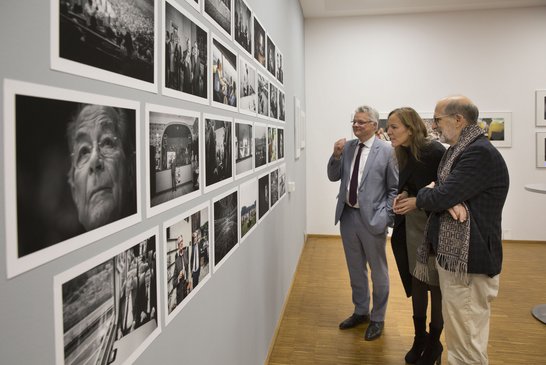Michael Jostmeier: Exhibition opens
With Michael Jostmeier's exhibition "Unterwegs 1976 - 2024", the City of Hof's Department of Culture is presenting a picture show in all the foyers of the Freiheitshalle Hof that serves classic genres and shows current digital possibilities. At the invitation of Head of the Cultural Office Peter Nürmberger, the exhibition, which was on show at the Kunsthaus Nürnberg in the summer, has now been transferred to the Freiheitshalle in a new format.
At the opening event, Kunsthaus director Michael Dachwald introduced the life and work of the now retired professor of GCI, Computer Generated Imagery, to the large audience attending the opening. Michael Jostmeier is one of the pioneers of the combination of computer graphics and photography, which he has been working on since the early 1980s. He is also a trained photographer with a diverse oeuvre, which has become known to a wider audience through the exhibitions in Nuremberg and now in Hof. Michael Jostmeier studied visual communication at the Folkwangschule in Essen, specializing in photography with the legendary photographer Otto Steinert, the founder of subjective photography, as well as with Inge Oswald, whose assistant he was after graduation. At the same time, he began photographing the election campaign appearances of Johannes Rau, who later became Minister President of North Rhine-Westphalia and President of Germany. Initially on a freelance basis, then as a permanent member of the entourage for photographic documentation. This brought him into photographic contact with numerous political figures of the time, such as Willy Brandt, Helmut and Loki Schmidt, Helmut and Hannelore Kohl and Franz Josef Strauß. He founded a design agency and was later appointed Professor of Photography at the Georg Simon Ohm University of Applied Sciences in Nuremberg.
Over the years, Jostmeier has not only traveled, but also photographed in different areas: Travel photography with a large-format camera, landscape and street photography, but also documentary photography and, time and again, computer-generated photographs.
Michael Jostmeier experimented with the pinhole camera mainly during his professional travels, also to relax and create a counterbalance to the stressful life in the design agency. In addition to the Eiffel Tower, photographed during its 100th anniversary, or the old Chinese monasteries, one focus is on New York City: the Brooklyn Bridge, the Empire State Building and the World Trade Center in the skyline and from above, from the former visitor platform. Views of a bygone era with the medium of a bygone era and yet so aesthetically powerful that, like the medieval San Gimignano in Tuscany, they appear to have been removed from time in the pinhole camera prints.
The exhibition is complemented by the photographs of Heinrich Jostmeier. The photographer's father already had his own exhibition at the Museum Folkwang Essen in 1990. His photographs are a valuable historical document of the subjective insight into the West German world of the 1950s and 1960s and are shown here in a screen presentation.
Peter Nürmberger, Head of the Cultural Office, used his speech to ask how he always finds these exciting people to show in his exhibitions. He said that recommendations and trust were essential, which then proved itself in spectacular exhibitions of famous photographers such as Barbara Klemm, Isolde Ohlbaum and Stefan Moses. It is not a matter of course that the big names are attracted to Hof. An advocate is always helpful - or, as in the case of Jostmeier, a decades-long connection. Nürmberger's conclusion: "With a little pride, we can say that Nuremberg and Hof are the places in northern Bavaria where photography plays a role in the exhibition scene."
Nürmberger had already made contact with the design faculty at the Ohm University of Applied Sciences in Nuremberg in 1985 and had posters designed for the Hof Theater at the time. Over the years, projects were repeatedly designed for the city of Hof and an exhibition by his students was also organized with Professor Jostmeier in 2019.
Mayor Eva Döhla's statement in favor of Hof as a cultural location provided an accentuated closing point. She made a plea for a rich cultural life, from so-called high culture to the independent scene, which is far more than just entertainment or an economic location factor.
